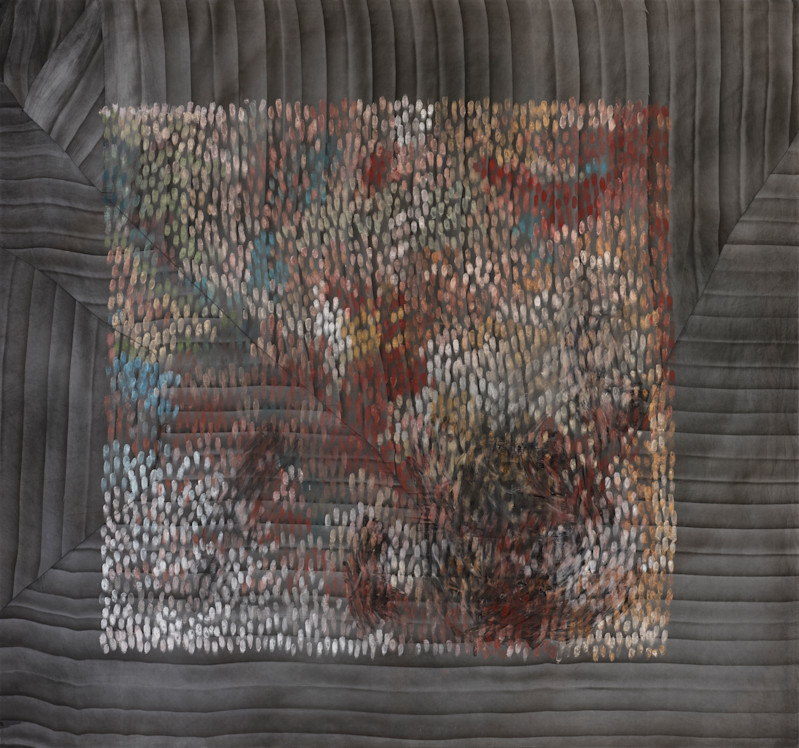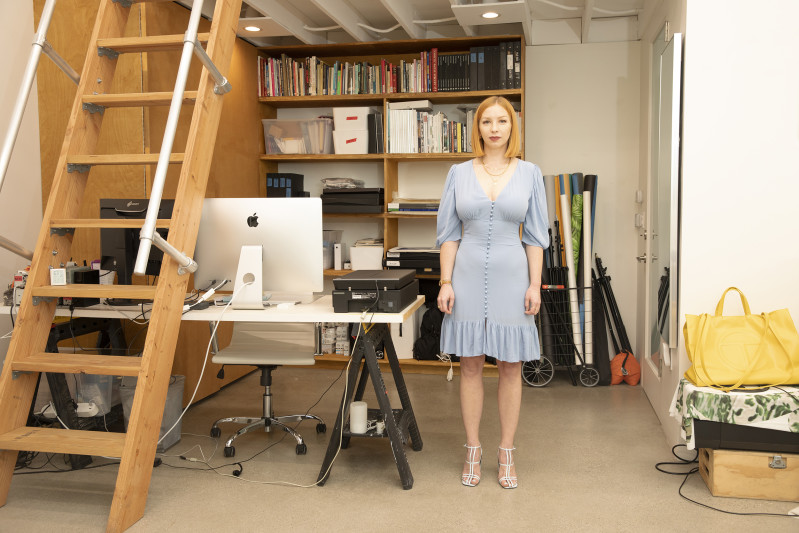Erica Mahinay
Interview
October 4, 2022

Erica Mahinay in her studio in LA
Thanks to her mother, Erica Mahinay started painting when she was about four years old. Mahinay later spent her childhood and teenage years between New Mexico and Kansas, where she continued to absorb the unique potent ideas and activities from her mother – Zen meditation, Shamanism, psychology, consciousness, and somatic therapy.
Why did you become an artist?
My Mother tells a story about taking a workshop called “Painting from the Source” and becoming so invigorated by her experience that afterwards she covered all the walls and floors in our home with paper, removed most of the furniture, and spread out buckets of paint and brushes to be used at will. We lived like this for a short period of time while she divorced my father. I was an impressionable four-year old and apparently during this phase she says that I announced my intention to become an artist. She prioritized a mindset of living life with passion and fullness, despite the realities of her being a single mother with limited resources. Learning from her how to shift from a mindset of scarcity to one of self-generated abundance is one of my greatest privileges.
Where did this promising and early beginning lead you?
This osmotic education preceded my formal art school training and I attribute it giving me a core framework for integrating visual histories into my own language and experiences: preoccupations with death and human existence as exemplified through vanitas and Dutch still life painting; explorations of time, light and vision as seen through impressionistic and pointillistic accumulations of color and mark; gestural abstractions that stand on the shoulders of Cy Twombly or Joan Mitchell; or the conceptual endeavors of action painting and trace with reference to the Gutai Group or Ana Mendieta. Conversing about life through art gives me both humility and purpose.
Attraction to these themes and dialogues drove me towards the Kansas City Art Institute and then the Cranbrook Academy of Art.
What is your experience as an artist in LA?
I initially came here because of logistical reasons – time, space, and community. But I quickly realized this city also makes sense for my work, given my mother’s interest in mind expanding practices, a theme that made its way into my work. California, with its history as a counterculture, health and wellness mecca has certainly been a fertile backdrop for making work in the spirit of identity forming and embodiment practices.

Erica Mahinay, Particle Time (Focus), 2020, Raw pigment and acrylic on silk and poplar, 157.48 x 147.32 cm
Your artistry combines various materials and textures, like paint and cloth. What is it that attracts you to mixed media?
Using a variety of materials lends me the ability to create a language of adjacencies. It helps me maintain an expansive practice in which I can utilize the sensorial aspects of a material or lean on associative qualities. Lead for instance is a newer material that has worked its way into only a couple of paintings so far – I’m attracted to its weight. That it folds itself over whatever it is resting on. It’s too soft to support its own weight, so in sheets, it behaves more like fabric than metal. Silk is seemingly delicate, comes in a variety of translucencies and sheens, absorbs dye with intensely saturated results. It also comes with associations with the feminine and the erotic. I return to a lot of these materials with new approaches – their meaning isn’t part of a fixed equation for me. Part of the joy is that the meaning of a work shifts with different uses and combinations of materials and processes.
How did you discover your own unique style as an artist?
Much of my work has been about embracing imperfection and about being present enough to recognize when something surprising or out of my control is more interesting than I am. In terms of language, my “style” has evolved organically with what keeps me interested and chasing – finding new methods and materials that challenge me beyond what I am capable of doing in terms of skill or in terms of my ideas. Sometimes I think too much weight is placed on “intention”. People want to feel that an artist meant to do what they did – that they have the knowledge or skill to present something exactly as they intended. The most valuable thing I took from formal education was the ability to recognize the difference between intention and impact and let the work do most of the thinking.

Erica Mahinay, Time Traveler (Sifting), 2020-21, Raw pigment and acrylic on silk, poplar 152.40 x 101.60 cm
Photos by Daniel Sahlberg.



